Pros
Cons
Physical Tour
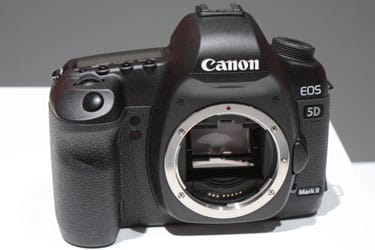
Front
The major feature of the front of the 5D Mark II is the large EF lens mount. This is where the SLR lens goes, and you can see how the lens mechanism fits int the camera body. The others features include a 5D logo and the Mark II logo on the left, and the emitter used for focusing in darkness) for the focus assist and the receiver for the optional remote on the right ( and the shutter button nearest the top.
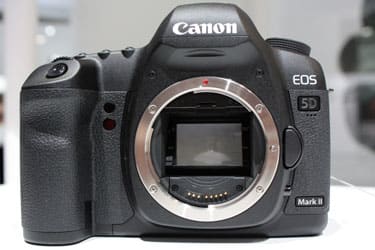
The 5D Mark II has a relatively clutter free front.
Back
Many of the controls for this complicated camera are on the back of the body. From the top right going clockwise, we have the AF-On button (which controls the auto focus function), then the playback zoom controls. To the left of the screen are the two main controls; the directional joystick and the scroll wheel. The former is used to navigate the different levels of menus, while the wheel is used to scroll through lists of options. A set button in the center of the scroll wheel selects the option. Below this is the camera on-/off switch which can also disable the scroll wheel; useful if you keep accidentally jogging it. Then we have the screen; a big, bright 3-inch LCD screen, with 920,000-dot resolution, that dominates the back of the camera. Above this is the viewfinder and live mode button; which puts the camera into live view mode. To the left of the screen are five buttons; from the top, these are for accessing the menu, setting the color mode, showing or hiding on-screen info, entering playback mode and deleting photos.
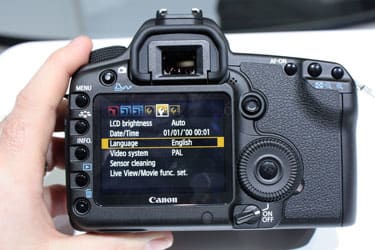
The back of the 5D Mark II is dominated
by the 3-inch screen.
Sides*
*The left side of the Canon 5D Mark II is where most of the action is when it comes to ports and sockets; under two rubber panels are the power sockets, the remote control socket, the microphone input, the A/V output socket, the USB port and the mini HDMI port.
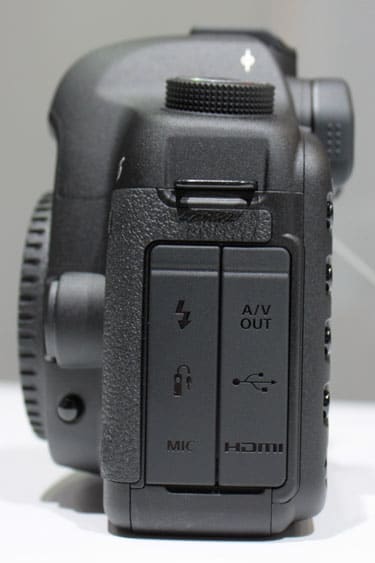
The left side of the camera is where most of the action is for
ports and sockets**
By comparison, the right side of the camera is rather uninteresting; the most exciting thing here is the cover for the CompactFlash card port. There is also the lanyard loop, which on the model we looked at, had a metal cable in it to stop people like us from walking off with the demo model at the Photokina show. This is not a standard feature, unless you don't trust yourself. The CompactFlash port cover opens with a simple push backwards, whereupon the cover flips out.

*The only major feature on the right side is the cover for
the CompactFlash port
*
The top of the 5D Mark II has a number of interesting features, including (from the right) the shutter button, the control wheel and a series of function buttons. These control the metering mode and white balance, the auto focus and drive modes, and the ISO and flash exposure compensation. Each button has two functions because they use both the top control wheel and scroll wheel on the back; if you press the first button, the top control wheel sets the metering mode, while the back scroll wheel sets the white balance mode. Below these buttons is the secondary screen, which contains a lot of information on the current shooting mode, the metering mode, the amount of space left on the card, etc. Next we have the flash hot shoe, which is a standard type, but which also supports Canon's own Speedlite II range. Finally on the right we have the control dial, which has 10 spots for shooting modes.

*The top of the 5D Mark II is the home to a
number of commonly used controls*
The bottom of the 5D Mark II has its charms as well, especially for tripod users. In the center of the base is the solid metal tripod socket, which should grip tightly in pretty much all situations. To the left of this is the cover for the battery socket. The small plastic cover to the right covers a proprietary connector for the optional battery grip.

*The bottom of the 5D Mark II is where the battery of the
camera fits, as well as the tripod socket
*
Components
Viewfinder
The viewfinder of the 5D Mark II is all that you would expect of a camera in this class; it's clear, bright and comfortable on the eye. We were not able to measure the coverage of the viewfinder in our explorations at the Photokina show, but it seemed to be pretty close to the 98 percent that Canon claims, and definitely felt improved from the original 5D, which cropped out the edges of the image from the viewfinder. The in-viewfinder information shows pretty much everything that is shown on the top menu, making it easy to control the cameras without taking your eye off the subject. A small diopter adjustment wheel on the right of the viewfinder allows for adjustments for the visually challenged, but we found no problems using the viewfinder with spectacles. Canon offers a number of replacement focusing screens that present different lines and boundaries in the viewfinder, including a grid and super precision screen that makes it easier to focus in low light. Another interesting thing to note is the small microphone to the left of the viewfinder, which can be used to record narrations on the video that the camera records.

Sensors beneath the viewfinder turn the LCD off
when you hold the camera to your eye.
LCD Screen
The 3-inch LCD screen is a definite step up from the 2.5-inch display of the 5D; the screen is not only bigger, but feels brighter and easier on the eye. That's probably mostly due to a huge jump in resolution, up to 920,000 pixels. The 5D screen had just 230,000. The Mark II is a substantial improvement, making it much easier to check focus, and presenting more information on the screen without getting in the way of the photo itself. The screen has 7 levels of brightness, and can automatically adjust the brightness depending on the light level.

The LCD screen of the 5D Mark II is a big improvement
on the original 5D; it is bigger, brighter and sharper
Flash
Unlike most modern SLRs, the 5D Mark II does not come with a built-in flash. This is an interesting decision by Canon; built-in flashes generally produce poor results (especially on the more finicky SLRs), but they can be useful. However, if you can afford the $2699 sticker shock of the 5D Mark II, chances are you can spend an extra few bucks on a compatible flashgun. The 5D Mark II also goes against the annoying trend of manufacturers coming up with flash hot shoe styles that only work with their flashguns; the 5D Mark II will work with any flash with a standard hot shoe. It will, of course, work best with a Canon Speedlite II flash (these include Through The Lens, or TTL, metering), but it's reassuring to know you can buy a cheap generic one if yours breaks down or gets lost when your baggage is redirected to Paris for no good reason by Lufthansa.
**
****Lens Mount**
The lens mount on the 5D Mark II is the standard EF lens mount, which brings compatibility with a huge range of lenses, from the short and wide to the tall and very long. No lens is included as standard with the 5D Mark II; you have to either buy a lens or use one of your existing lenses. Because the camera has a full -frame sensor, there is no multiplier; you'll get the full range of focal length from a zoom built for a 35mm film camera. However, the point to note is that the 5D Mark II is not compatible with the EF-S lenses that the lower-end of Canon's SLR range uses. So, if you are upgrading from a Digital Rebel, you may not be able to use some of your lenses.

The lens mount of the 5D Mark II will work with EF lenses, but
not with the EF-S lenses that are used on lower end Canon SLRs
Connections
Underneath the two rubber covers on the right side of the camera is a veritable banquet of plugs and sockets, including a mini HDMI port for connecting to an HDTV, a mini USB port for connecting to a PC, an A/V out port for connecting to an analog standard definition TV, a microphone input, a wired remote control socket and a power socket. Pretty much the only thing missing is a FireWire port and a time travel port that allows you to download your photos before you've taken them. The microphone port is especially interesting; this is the first camera we've seen that includes this port that has migrated from a camcorder. We weren't able to test the quality of the internal microphone, but they are seldom as good as an external microphone, so it is great that Canon has included this as an option.

Any port in a storm, and the 5D Mark II has ports to spare
Battery
The 5D that we looked at was juiced up by a small 1800mAh battery that fits into the handle. Although this particular unit was marked as being for European use only, it seems that this same model of battery will be used in the U.S. We weren't able to test the battery life of the camera using this battery, and Canon has not released any figures for expected battery life. However, we found that the 5D had an excellent battery life, and we expect the Mark II will likely do the same, though the bigger screen may prove to be more of a power drain. We'll know more about this when we drag a final production unit into our lab for a through examination.

The battery of the 5D fits into the grip
of the camera

The battery of the 5D holds 1800mAh of charge
Memory
The 5D Mark II also bucks the trend in not using SDHC cards. Instead, it uses the old faithful CompactFlash. This will be welcomed by anyone who has invested in a lot of big, fast CompactFlash cards, but does again mean that anyone who is upgrading from one of the newer Canons that have moved over to SDHC cards will have to buy new storage. We found the cards to be very easy to remove and install; with practice, we could do it in just a few seconds, which will be welcomed by anyone trying to shoot quickly who runs out of space.

The 5D Mark II uses old school CompactFlash cards
not the newer SDHC type.
Design / Layout
Model Design / Appearance
The 5D Mark II will never be described as stylish. Functional is more appropriate, but that's fine in a camera like this; it's a tool designed to do a job, and the design has to serve this. And it does this very well; we found that the camera, although bulky, fits into the hand well and puts the most commonly used controls under your fingertips.
Size and Handling
The 5D Mark II is a large camera, but it fits well into the hand and is comfortable to hold for extended intervals. The leather-textured plastic on the exterior help you keep a firm grip, and the handgrip is wide and big enough to make sure that your grip is unlikely to slip. That's a good thing for an expensive camera like this. Although the camera can be used single-handed, the more comfortable position is to use two hands; one on the grip and the other under the lens, bracing the camera.
The 5D Mark II is also a pretty heavy camera; Canon quotes a weight of 28.6 ounces, and that is without the lens. Most lenses will add another 10 or more ounces to the weight, so you are carrying around a significant burden with this camera. Even with the neck strap, it does tend to weight you down after a bit.

*

-
The 5D Mark II is a large camera, but it fits comfortably in the hand
We found the handling of the 5D Mark II to be generally very good; the index finger falls right on the shutter button and the thumb falls right on the controls at the back of the camera. Because of the size of the camera, it is easiest to use with two hands, but we did find that it was possible to carry out many common operations (such as changing the ISO) with the eye to the viewfinder; the index finger can reach the ISO button, then use the control wheel to change the setting.
Menu
The menu structure is the standard Canon approach; the on-screen menus are broken up into 5 separate screens. The first is for shooting, and contains options like the resolution of the image and how long the image appears on the screen.
*

The second menu screen covers playback settings, such as erasing and protecting images.*
**

The third menu covers other playback settings, such as what the histogram on the information display covers and whether blown-out highlights are shown.
*
**

The last three menus cover the settings of the camera, allowing control of features such as image rotation, language and the battery.
*
**

**

The Live View/Movie func. set option is where the video controls of the 5D Mark II live; we'll get to those in a bit.
**

Ease of Use
The 5D Mark II is a professional camera, so the number of features and buttons on offer are always going to be somewhat overwhelming. But it does a decent job of breaking down the menus so that the features are easy to find. Our only real complaint is that Canon decided to put some infrequently used options right up at the front of the menu structure; one of the first things you see when you hit the menu button is the option that allows you to set the camera to shoot without a memory card being installed, which you are likely to use about one every 10,000 years.
Modes
Auto Mode
Although it is not a point-and-shoot camera, the 5D Mark II has a fully automatic mode; just set the mode dial to the green rectangle and the camera takes over and makes all of the decisions, including focus mode, white balance, etc. A more commonly used mode will be the P mode, where the camera makes most of the decisions, but the user can step in and control aspects such as focus mode, metering mode, white balance setting, etc.
Movie Mode
Movie modes on SLRs is definitely one of the big trends we are seeing this year; Nikon got it out first on the D90, but the Canon 5D Mark II has a much wider set of features, and is more likely to actually prove to be useful. The movie mode is accessed by putting the camera into live view mode (by pressing the live view button), whereupon the camera shows a live video preview on the LCD screen. The two darker areas at the top and bottom of the screen show where the video will be cropped. One thing to note here is that it's not a question of shooting stills or video; both are available. Pressing the shutter button will take a photo, while pressing the set button will start a video recording.
*

-
Pressing the info button brings up more shooting info, such as the color mode, the video mode and the video autofocus mode.
*

Pressing the set button starts the video recording; a small red dot in the top right indicates that the recording is underway.*
*
*

*
Focusing is a big issue with cameras in live mode, and this carries over to the video mode. Like all SLRs, the focus sensor is in the prism at the top of the camera, so it can't be used when the camera is in live view mode. This means that the camera has to either drop the mirror down to focus, or use the imaging sensor itself for focusing purposes..
*
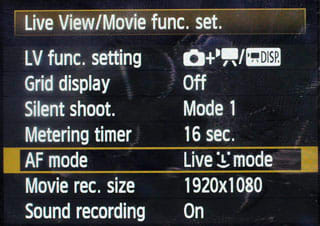
*
The 5D Mark II offers three focusing modes for video: quick mode (where the mirror flips up to focus when you press the AF-On button), Live mode (which uses contrast detection focusing straight off the image sensor) and the oddly named Live :-) mode. This last one is a face detection mode; when the camera is in this mode, the imaging sensor will try and detect faces and focus on them, highlighting the faces with a small box. The technology is inherited from Canon's camcorders and it seemed to work reasonably well in our brief tests; it detected faces, highlighted them and kept them in focus. The other modes work less well; in the quick mode, you have to focus before you start shooting and then hope that the subject doesn't move; the camera won't refocus when shooting a video. The Live mode refocuses the camera when you press the AF-on button, but it is rather slow and didn't seem to work well in the rather dimly lit hall. It also added a very unpleasant flicker to the video, which was recorded. We also have concerns about noise; the SLR lens is somewhat noisy when it focuses, and this could be picked up by the microphone on the front of the camera.
*

*
The video that the 5D Mark II captures is high definition, shot at a 1920 x 1080 resolution. Canon did not specify if the video is shot interlaced (1080i) or progressive (1080p), but we think it is the former. Canon also has not released any information on the bitrate that the video is saved at. That is a critical bit of information. Higher bitrates mean less compression and (typically) higher quality video. The Canon rep on the stand told us that the maximum video length at the highest resolution is about 12 minutes, and that the maximum size of a single video file is 4 Gigabytes. From this, we can infer that the bitrate is somewhere around 5 Mbps, which is somewhat less than most dedicated camcorders. The video files are saved as QuickTime files using the high quality H.264 video codec. However, we will have to wait for a review unit before we can draw any real conclusions, as the Canon reps on the Photokina stand started shouting at us whenever we tried to use our own memory cards to capture a video to examine more closely, and we are sensitive people who don't like to be shouted at.
Basically, the video mode looks to be a useful addition to the camera, and appears to produce relatively decent quality video. However, the focusing looks to be an issue, and this may limit it to situations where you can focus, then shoot. With this limitation, the 5D Mark II won't work as a camcorder that you carry around, as you'd likely end up with a blurry mess. We'll have to do more real-world tests before we can decide if it is good enough to possibly replace a camcorder. Unfortunately, Canon would not allow us to take any video of our own with the camera, so we can't make any judgments on the quality of the video. Rest assured that we'll be giving the video features a full examination once the final units are ready for review. *
*
Drive / Burst Mode
Canon claims that the 5D Mark II can capture 3.9 frames per second, and we found no reason to dispute this in our hands-on tests. We also see no reason to dispute Canon's claim of being able to capture 9 frames in a burst in RAW mode, and 78 when shooting JPEGs. We didn't count, but we could certainly keep shooting for a very long time at the full rate when shooting JPEGs. Both of these are very impressive figures, and will be welcomed by sports shooters in particular; that is easily a long enough burst to capture an entire football play and then pick out the best shots afterwards. However, it is worth remembering that there are many cameras that can shoot more frames per second if that is a critical feature. The unique Casio EX-F1 can shoot 60 frames a second, and the Nikon D700 can manage 5 frames per second.
Playback Mode
The playback mode of the 5D Mark II is flexible, but straightforward; you can view up to 9 images on the screen, and we found that we could quickly skip through large numbers of images, then zoom in on the best one. The two buttons on the back right corner of the camera allow you to zoom in up to 10x; plenty of magnification to make critical judgments on the focus of an image.
All of the usual suspects are also present for the information on photos; you can look at histograms of overall luminance and separate colors, review the shooting time and date, have image highlights flash on screen and survey many other bits of information. Basically, all of the tools that a pro shooter is likely to need about their photos are available, with the exception of next week's winning lottery numbers.
Custom Image Presets
If you're looking for scene modes on the 5D Mark II, you're looking at the wrong camera. High-end SLRs like this don't have scene modes. Instead, the camera offers three custom modes that allow you to save your own groups of settings. This is a useful tool; you could create one set of settings for indoor shooting, and another for outdoors, then quickly switch between them as you move from location to location.
Control Options
Manual Control Options
As befits a camera of its station, the 5D Mark II has a huge selection of manual modes; pretty much every aspect of the camera can be tweaked, poked and otherwise prodded to the requirements of the shooter.
Focus
Auto Focus
The 5D Mark II has a 9-spot auto focus system which we found to be snappy and responsive, even in relatively low light. Four auto focus modes are available: Auto, One-Shot AF (which focuses when you press the shutter halfway down), Predictive AI Servo AF (which tries to continuously refocus based on the movement in the image) and AI Focus AF (which takes a similar approach). There is also a manual focus mode that disengages the motor and lets you do your own focusing. How easy this is to do depends on the lens; many Canon lenses have only a small focus ring, but others offer a bigger, more comfortable focus ring.
ISO
The 5D Mark II has a very wide selection of ISO settings, ranging from 100 to 6400 in one third of a stop increments. However, it doesn't stop there; there is also one lower setting (called L) that pushes the ISO down to about 50 and two higher modes (called H1 and H2) that push the ISO to approximately 12800 and 25600. We were not able to take any photos off the camera to judge the quality of images at these higher settings, but noise definitely seemed to be an issue at the H2 setting; iamges looked distinctly grainy on the screen. That's no surprise, but we'll have to wait until we get the camera into the lab before we can really judge the noise level.
**
White Balance**
A good selection of white balance presets are available; Auto, Daylight, Shade, Cloudy, Tungsten Light, White Fluorescent Light and flash, plus manual white balance and a setting for directly entering the color temperature. The white balance point can also be tweaked by up to 9 stops in either direction, as well as tweaking it on the individual color axes. Auto white balance bracketing of up to 3 stops on either side is also available.
Metering
Four metering modes are available; evaluative (which uses 35 zones to judge the correct metering), partial (which uses an 8 percent area at the center of the image), spot (using a 3.5 percent area) and center-weighted average. That's a pretty standard assortment, which should cover most needs.
Shutter Speed
The 5D Mark II has a very impressive shutter speed range; the shortest is 1/8000 of a second and the longest is 30 seconds in the bulb mode. The standard flash sync speed is 1/60 of a second, but that can be sped up to 1/200 second with one of Canon's own flash guns.
Aperture
The aperture range depends on the lens installed, but the 5D Mark II has the standard connections that allows it to work with all compatible lenses, except some really old Canon manual lenses. It won't work with the EF-S lenses that come with some lower-end digital SLRs, though.
**Image Stabilization
**No image stabilization is present on the camera body; Canon puts those features into the lens on their SLR cameras. Some other manufacturers use sensor-shift stabilization , where the image sensor can move to compensate for hand movements, but Canon has not added this to the 5D Mark II. However, an increasing number of Canon lenses now include optical image stabilization, where an element of the lens moves to correct for small movements.
Picture Quality / Size Options
The 5D Mark II offers a good selection of picture quality and size options. The sizes offered range from 5616 by 3744 pixels down to 2784 by 1856 pixels, and two quality levels are available (fine and normal) for JPEG shooting. The 5D Mark II can also shoot both RAW and JPEG images at the same time, saving both files to the same memory card. This is very convenient as it offers the speed of JPEG, but also the tweakable image quality of having the RAW version available. The RAW files are approximately 25.8 MB in size, so you'll need a large memory card to store more than a handful of them.
Picture Effects Mode
The 5D Mark II eschews the usual picture effects mode found on point and shoot cameras; you can't add borders, speech bubbles or the like. This is no great loss, but one thing that is very useful is a range of color modes. Like most Canon SLRs, the 5D Mark II offers a number of picture styles that tweak the color and sharpness of the JPEGs, including modes for standard, portrait, landscape and faithful color. Although we have not tested the 5D, we have found that with other Canon cameras the Faithful mode is generally the most accurate for capturing and representing accurate colors.
Conclusion
**
Conclusion**

The Canon 5D was beloved by many photographers, both amateurs and pros, as a workhorse camera that could take great images, and the 5D Mark II looks likely to continue this great tradition. Although our full review will have to wait until we can get one into our labs for a thorough probing, we didn't find anything that gave us cause for concern in our hands-on tests at the Photokina show.
And the Mark II adds a number of interesting new features to the mix. Although the video mode has its limitations, it looks to work well and could prove to be useful enough for the photographer who wants to produce occasional videos -- as long as they don't involve much focusing flexibility. In our limited testing time, we found that the best way to use video mode was to focus, then shoot and hope the subjects don't move much. We doubt the 5D Mark II will replace a dedicated camcorder, but it has a number of interesting touches (such as the external microphone port) that could make it good enough for occasional video clips, as well as being a totally kick-ass camera for the serious (and seriously well-heeled) shooter.
Specs / Ratings
**Specs Table
**{{manufacturer_specs_table}}{{raw_scores_table}}
Meet the tester
Richard Baguley is a veteran writer who has written about technology ranging from Alphabet to Zip file utilities. He has contributed to pretty much every major tech publication, including Amiga Format Magazine, PC World, Wired, CNET, Toms Guide, Forbes, and many others. He lives in the Boston metro area with his wife, dog, and an indeterminate number of cats.
Checking our work.
Our team is here to help you buy the best stuff and love what you own. Our writers, editors, and experts obsess over the products we cover to make sure you're confident and satisfied. Have a different opinion about something we recommend? Email us and we'll compare notes.
Shoot us an email